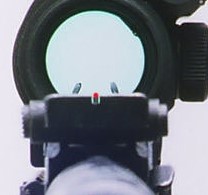There are several other choices that lay in between the $79 Primary Arms product and the $600+ item from Aimpoint.
One line of red dot optics that I’ve grown to like over the years is from a family-owned company called Ultradot. Their entry level product is the Ultradot 30, which is a compact, lightweight tubular sight that was designed for Bullseye competition. If you go to a match anywhere in this country, you’ll see a lot of Ultradot’s mounted on 1911s.
I happen to think any of their tube type sights are a great choice for an AK. At 3.9 ounces, the Ultradot 30 is really light.
The optics are also quite good — up to par with much more expensive glass.
The 4 MOA red dot is surprisingly crisp and features an 11- position, adjustable brightness dial. The more expensive Ultradot models, such as the Ultradot Match, offer adjustments for light intensity as well as a separate dial to change the size of the red dot.
Engineered in the U.S., the Ultradot line is manufactured in Japan. Because they were designed to work with the hard recoil of a 1911, they are built to take a pounding. I’ve owned several of their models and have had no problems with them.

I mounted my Ultradot on an Arsenal scope mount using 30mm rings, but it also works with the RS Regulate system. Note that but because of its configuration (it’s about 5 inches long) it needs to be mounted with RS Regulate’s longer-railed AK-303 model and fitted with two 30mm ring mounts.
At $190, including a lifetime warranty, the Ultradot 30 is a superb deal. If you really want to save money, check out the bulletin boards of bullseye shooters where you can pick up a used Ultradot for about $100.

Another inexpensive red dot optic that is favored by our optic’s guru, Tim Yan, is the Vortex StrikeFire II.
Vortex is a Wisconsin-based company but manufactures its products in Asia. The StrikeFire II is made in China. At $179, it’s not going to break the bank and the quality (plus its warranty) is quite good.
The first thing that strikes you about the Strikefire II is how robust it is. It’s built like a tank and screams “tactical.” The single-piece chassis is compact and weighs in at 7 ounces. It’s a little heavier than the micro dots and tubular models from Ultradot but reportedly can handle a lot of abuse.
It’s a snap to mount on an AK. It comes with a cantilever-type mount for an AR, but you’ll dispense with that if you use the RS Regulate system with their 30mm ring.
Unlike other tubular-type optics, the Strikefire requires only one ring, which secures the unit in the middle of its casing. You can make horizontal and vertical adjustments using the top of the plastic caps which have a ledge that fits into the screw tops. Aimpoint uses the same system and it’s a very thoughtful adaptation.
One of the most important points is the quality of the Strikefire’s red dot, which is surprisingly good for the price.
Another very big plus I discovered using this scope is that in concert with the RS Regulate mount it will co-witness with a VEPR. One cannot do this with an Aimpoint or any other micro dot that I’m aware of.
I looked at the red-only version, which Tim Yan prefers, because it’s brighter than the green-red version.
The Lithium CR2 battery has a life at maximum brightness of 300 hours. It also has an automatic 12-hour shut-off, which is very handy for people of a certain demographic (such as myself). As an optic designed for plinking, hunting and the range, it’s ideal, especially for the price point.
Another one of Tim Yan’s favorites is the 2 MOA (minute of angle) Hi-Lux Micro-Max B-DOT. Call it a T-1 alternative or an Aimpoint clone; it’s a sturdy little red dot priced at around $200 with an impressive life of 55,000 hours (6.2 years) on a CR2032 battery. Thus it’s equivalent to the $700 Aimpoint when it comes to staying power.
Of course, you can use it on any mount that will accept an Aimpoint. The unit has 12 brightness settings accessible on a dial atop the aluminum housing. The lowest two settings work with night vision. The scope will automatically shut down after eight hours of use (with the factory default settings) but you can configure it manually for anywhere from between 2 to 12 hours.

The elevation and windage adjustments elicit positive clicks that move the point of impact 0.5 inch at 100 yards (1/2 MOA). Like the Aimpoint and the Vortex Strikefire, the tiny caps that cover the adjustment knobs have little flanges that can be inserted into the notch at the top of dial, so that you can tweak the elevation or windage without using a coin or screwdriver.
Two flip-up lens covers are included as well as an extra battery that resides inside the battery cap. This is a sturdy little beast. The finish on this product is also excellent
The quality of the red dot is crisp and shines intensely, even in bright daylight.
When you consider the Micro-Max B-Dot, along with the Strikefire II and Primary Arms scopes, which are manufactured in China, it’s clear that the Chinese have come a long way in improving the quality of their optics.
This scope is fully submersible and has been used at temperatures as low as -85 degrees Fahrenheit and as high as 167 degrees Fahrenheit. It’s been tested with a semi-auto .338 Lapua, which has more than a healthy kick, and passed with flying colors.
I think this product is well worth a look.

If you’re going to use an AK in the 100+ yards range and you don’t want to spend a lot of money, consider the Primary Arms 1-6x scope with the ACSS (Automatic Combined Sighting System) Reticle.
This style of reticle which is designed for a 7.62 x 39 cartridge is generally what you’d find on a much more expensive scope such as a Trijicon or a Browe. (Note that there are many variations of reticles, including dots, posts, circles, scales, chevrons or a combination of these).
The scope utilizes a battery to illuminate the reticle for low light conditions. If you’re shooting during daylight hours it’s generally not even necessary to switch on the illumination.
Eye relief, at up past 4 inches, is quite good. (Eye relief is the distance from the last surface of an eyepiece at which the user’s eye can obtain the full viewing angle. If a viewer’s eye is outside this distance, a reduced field of view will be obtained).
The 6x zoom provides a ton of flexibility so that you can engage targets at a wide-ranging distance envelope. The reticle offers a bullet-drop compensator and other nifty little tables that allow you to estimate the range and other variables such as the wind.
To set up the reticle properly, you’ll need to sight in the dot at the center of the horseshoe at 100 yards.
At 10 ¾ inches, weighing in at 17.4 ounces, this is not a small scope. If most of your shooting is off the bench, this won’t be an issue. If you’re going to be shooting long distances, you will absolutely need it.
Priced at around $280, this optic isn’t going to equal what you’d get with the expensive glass. However, if your plans entail shooting at the range rather than doing a tour in Afghanistan, this scope is perfectly adequate.
On the other end of the optics spectrum is a new import from Wolf Performance Optics which is now bringing in the PSU 1x/4x variable zoom optical gunsight, a high end scope from Russia. This model utilizes some very advanced technology and employs top of the line SCHOTT glass from Germany for its lens and prism. According to our optic’s maven, Tim Yan, at 4x the image quality and contrast is reportedly exceptional. The BDC (Bullet Drop Compensator) on the reticle is calibrated for a 62 grain (5.56mm) round to 800 meters but Tim reports that AK users will be able to use a 5.45x39mm bullet out to 300 yards. Additionally, Wolf offers a commercial 60gr 5.45×39 load that will match the 62gr 5.56mm NATO to 500+ yds. Price is around $1400. AK-74 users should be very happy.
























































































